Quick Look
Grade Level: 5 (4-5)
Time Required: 4 hours
(can be split into different days)
Expendable Cost/Group: US $0.00 In addition, this activity requires use of a non-expendable (re-usable) $300 LEGO® MINDSTORMS® kit; see the Materials List for details.
Group Size: 5
Activity Dependency: None
Subject Areas: Earth and Space
NGSS Performance Expectations:

| 4-ESS2-1 |
| MS-ESS2-4 |
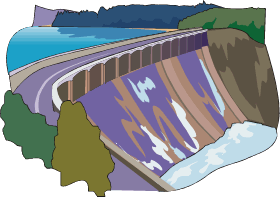
Summary
Students measure the permeability of different types of soils, compare results and realize the importance of size, voids and density in permeability response.Engineering Connection
Civil and geotechnical engineers design and build permeameters to measure the k-value of soils in the laboratory as well as in the field. The measuring process has become more and more accurate as modern tools are improved upon. Mechatronic tools, such as ultrasonic sensors, allow for a better reading of water collected and minimize measurement error.
Learning Objectives
After this activity, students should be able to:
- Measure the values of permeability in soils, k, through a basic laboratory model.
- Describe water flow in soils.
- Outline the applications of water flow models in practice engineering.
- Identify variables affecting permeability, such as particle size, porosity and compaction.
Educational Standards
Each TeachEngineering lesson or activity is correlated to one or more K-12 science,
technology, engineering or math (STEM) educational standards.
All 100,000+ K-12 STEM standards covered in TeachEngineering are collected, maintained and packaged by the Achievement Standards Network (ASN),
a project of D2L (www.achievementstandards.org).
In the ASN, standards are hierarchically structured: first by source; e.g., by state; within source by type; e.g., science or mathematics;
within type by subtype, then by grade, etc.
Each TeachEngineering lesson or activity is correlated to one or more K-12 science, technology, engineering or math (STEM) educational standards.
All 100,000+ K-12 STEM standards covered in TeachEngineering are collected, maintained and packaged by the Achievement Standards Network (ASN), a project of D2L (www.achievementstandards.org).
In the ASN, standards are hierarchically structured: first by source; e.g., by state; within source by type; e.g., science or mathematics; within type by subtype, then by grade, etc.
NGSS: Next Generation Science Standards - Science
| NGSS Performance Expectation | ||
|---|---|---|
|
4-ESS2-1. Make observations and/or measurements to provide evidence of the effects of weathering or the rate of erosion by water, ice, wind, or vegetation. (Grade 4) Do you agree with this alignment? |
||
| Click to view other curriculum aligned to this Performance Expectation | ||
| This activity focuses on the following Three Dimensional Learning aspects of NGSS: | ||
| Science & Engineering Practices | Disciplinary Core Ideas | Crosscutting Concepts |
| Make observations and/or measurements to produce data to serve as the basis for evidence for an explanation of a phenomenon. Alignment agreement: | Rainfall helps to shape the land and affects the types of living things found in a region. Water, ice, wind, living organisms, and gravity break rocks, soils, and sediments into smaller particles and move them around. Alignment agreement: Living things affect the physical characteristics of their regions.Alignment agreement: | Cause and effect relationships are routinely identified, tested, and used to explain change. Alignment agreement: |
| NGSS Performance Expectation | ||
|---|---|---|
|
MS-ESS2-4. Develop a model to describe the cycling of water through Earth's systems driven by energy from the sun and the force of gravity. (Grades 6 - 8) Do you agree with this alignment? |
||
| Click to view other curriculum aligned to this Performance Expectation | ||
| This activity focuses on the following Three Dimensional Learning aspects of NGSS: | ||
| Science & Engineering Practices | Disciplinary Core Ideas | Crosscutting Concepts |
| Develop a model to describe unobservable mechanisms. Alignment agreement: | Water continually cycles among land, ocean, and atmosphere via transpiration, evaporation, condensation and crystallization, and precipitation, as well as downhill flows on land. Alignment agreement: Global movements of water and its changes in form are propelled by sunlight and gravity.Alignment agreement: | Within a natural or designed system, the transfer of energy drives the motion and/or cycling of matter. Alignment agreement: |
Common Core State Standards - Math
-
Multiply and divide within 100.
(Grade
3)
More Details
Do you agree with this alignment?
-
Multiply or divide to solve word problems involving multiplicative comparison, e.g., by using drawings and equations with a symbol for the unknown number to represent the problem, distinguishing multiplicative comparison from additive comparison.
(Grade
4)
More Details
Do you agree with this alignment?
-
Use the four operations with whole numbers to solve problems.
(Grade
4)
More Details
Do you agree with this alignment?
International Technology and Engineering Educators Association - Technology
-
The process of experimentation, which is common in science, can also be used to solve technological problems.
(Grades
3 -
5)
More Details
Do you agree with this alignment?
State Standards
New York - Math
-
Multiply and divide within 100.
(Grade
3)
More Details
Do you agree with this alignment?
-
Use the four operations with whole numbers to solve problems.
(Grade
4)
More Details
Do you agree with this alignment?
-
Multiply or divide to solve word problems involving multiplicative comparison, e.g., by using drawings and equations with a symbol for the unknown number to represent the problem, distinguishing multiplicative comparison from additive comparison.
(Grade
4)
More Details
Do you agree with this alignment?
New York - Science
-
Make observations and/or measurements to provide evidence of the effects of weathering or the rate of erosion by water, ice, wind, or vegetation.
(Grade
4)
More Details
Do you agree with this alignment?
-
Develop a model to describe the cycling of water through Earth's systems driven by energy from the Sun and the force of gravity.
(Grades
6 -
8)
More Details
Do you agree with this alignment?
Materials List
Each group needs:
- permeameter device (can build your own using transparent containers, see Figure 1)
- 3 soil samples with varying permeability (such as gravel, sand, silt, and clay)
- LEGO MINDSTORMS EV3 robot, such as EV3 Core Set (5003400) at https://education.lego.com/en-us/products/lego-mindstorms-education-ev3-core-set/5003400#lego-mindstorms-education-ev3
- LEGO Ultrasonic Sensor available at https://shop.lego.com/en-US/EV3-Ultrasonic-Sensor-45504
- watch
- ruler
- computer
- paper and markers
- 3 two-liter soda bottles
- graduated jar
- small piece of stockings
- rubber band
Note: This activity can also be conducted with the older (and no longer sold) LEGO MINDSTORMS NXT set instead of EV3; see below for those supplies:
- LEGO MINDSTORMS NXT Brick
To share with the entire class:
- projector for the Soil Permeability Presentation
Worksheets and Attachments
Visit [www.teachengineering.org/activities/view/nyu_permeability_activity1] to print or download.Pre-Req Knowledge
Familiarity with basic number operations, including addition, subtraction, multiplication and division.
Introduction/Motivation
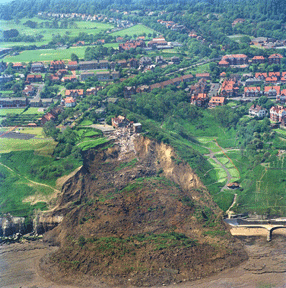
When it rains, where does all the water go? The water is in constant motion—some of it travels along the surface to rivers or lakes, some of it is absorbed by roots and plants, some evaporates and returns to the atmosphere, and much of it goes underground! Let's imagine pouring water onto a mountain of sand we have built on the beach. Where would that water go? Some portion of the water would go down the sides, while the rest is absorbed by the sand. Water tries to fill voids between sand or soil particles. Permeability is a measure of how willing the sand or soil particles are to let water fill the spaces between them.
Permeability is very important in civil engineering. In fact, permeability is often studied by engineers when designing water resource structures, such as dams. When designing and building retaining walls, excavations, bridges, land slopes, etc., engineers perform soil permeability analysis. Water flow analysis is also important in these construction projects.
For instance, in landslides and earth dams, the concepts of water flow and permeability are often used to estimate or predict the amount of water expected to come out in a certain period of time. The stability of slopes (such as in highways, excavations and dams) mainly depend on the presence of water runoff, infiltration and permeability because the water pressure built inside earth bodies causes additional forces that eventually act against the overall stability of the project.
Having knowledge of permeability allows engineers to design, calculate and build great structures, as well as correct and mitigate natural disasters in order to guarantee safe conditions and reduce the risk of damage or collapse.
(Optional: Show students the attached Soil Permeability Presentation.)
Procedure
Background
Permeability values can be determined in the field or in the lab. Soil permeability is determined in the lab with the help of two tests: constant and falling head (see attached PowerPoint presentation for details). In the field, soil permeability is determined by a pumping test, in which water is pumped from a well at a constant flow rate and the time it takes for the water to flow to reach steady state is measured (having a constant groundwater level makes the water come back to its original position).
This hand-on activity has three parts. First, students are introduced to permeability tests. Then, they conduct permeability tests with the use of a chronometer and rulers (students measure volumes and take analogue times). Finally, students conduct permeability tests with ultrasonic sensors, allowing them to minimize measurement error by using better technology (mechatronic components).
If possible, have students perform each test for all three soil samples. After testing soils with varying permeability (such as clay, sand and gravel), have students analyze their data and see that collecting data with digital vs. analogue practices affects the quality of the data collected.
Before the Activity
- Construct at least one permeameter device. The more soil permeability devices you create for the classroom, the more tests can be conducted simultaneously. See Figure 1 for the set-up. Make a basic permeameter device using transparent plastic or acrylic comprised of two main parts: the upper part where the water is poured; and the lower part where the soil sample to be tested is placed. Attach a flexible tube and a valve to the lower end of the device. Your permeameter device does not have to be identical to the one shown in the activity photographs. However, losses of water must be avoided, and flow continuity from top to bottom of the chamber should be guaranteed.
- Make copies of the Soil Permeability Pre-Evaluation, Soil Permeability Datasheet and Soil Permeability Post-Evaluation, one each per student.
With the Students
- Write the following terms on the classroom board and ask students to think about what they mean: soil, groundwater, voids and saturation.
- Explain how the permeameter device works, and use it with a natural soil sample (collected from outside). Demonstrate how water flows through the permeameter.
- Ask students how fast they think water will flow through three different soil types such as gravel, clay and sand.
- Divide the class into groups of five students each.
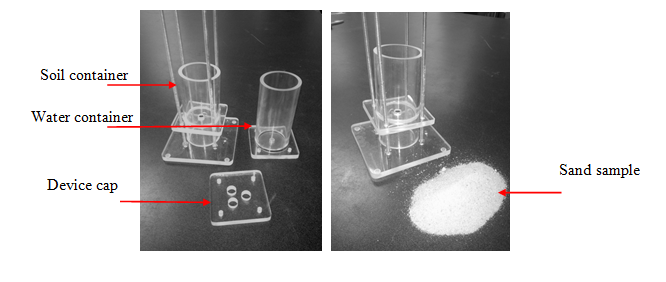
Figure 1: Permeameter device. 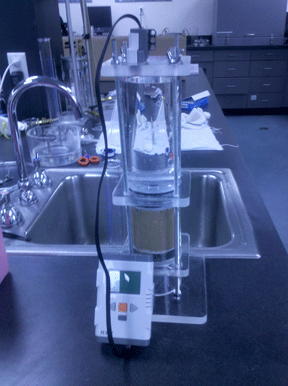
Figure 2: Ready for testing.
Part 1: Basic Permeability Test with Soda Bottles
Without any sophisticated permeameter device, have students run their first soil permeability test.
- Have students collect three samples of different soils (such as clay, sand and gravel).
- Help student groups each make three funnels by cutting three two-litter soda bottles to pour the soil sample inside (see Figure 3). Do not allow students to do this step. The three soda bottles will be used to test the permeability of the three different soil samples.
- Pour enough soil material to cover about ¾ of the bottle funnel. Have students pack down the soil with their hands, but have them try not to overly compact the specimen.
- Prevent losing materials by using a piece of stocking and a rubber band to cover the bottle mouth.
- Use a graduated jar to collect the exiting water. Use a watch or clock to measure the time it takes to fill the collection jar.
- Instruct students to use their Soil Permeability Datasheets as they gather and record their results. Students and teachers should look for the time it takes the water level on the jar to change between two known marks.
Part 2: Permeability Test without Ultrasonic Sensor
To run the test without digital measurements:
- Fill the lower permeameter chamber with soil. If only one chamber is being used, test one soil sample at a time.
- Fill the upper chamber with water. Next, open the valve, and allow water to flow through the soil. Wait until all air bubbles disappear, indicating that the soil sample is fully saturated.
- Close the valve and point out the initial and final water level marks on the chambers to students. Explain that the students will be looking for the time it takes for the water level to change between the two water level marks on the permeameter chamber.

Figure 3: Basic permeability test. - Once the test is ready to run, open the valve again and simultaneously starting timing.
- Close the valve again and stop timing when the lower water mark is reached. Have students record the results on their datasheets.
- Help students to estimate the water flow by dividing the distance of water level change by the time. Explain to students that this calculated value is proportional to the soil permeability.
Part 3: Permeability Test With Ultrasonic Sensor
This section is devoted to running the same experiment with another data recording system, a LEGO ultrasonic sensor. Ultrasonic sensors are able to detect the proximity of objects (in this case a changing water level). Conducting the experiment a second time with the use of an ultrasonic sensor allows students to witness the differences between data-gathering with analog (manual) and digital (mechatronic) tools.
- Repeat steps 13 through 16 while an ultrasonic sensor is connected to both the EV3 brick and the upper cap of the water cell, as shown in Figure 2. Use the LEGO MINDSTORMS code shown in Figure 4 to read the water levels and time this process. This code allows both the ultrasonic sensor and the timer to read values in real time. In other words, during the permeability tests, the EV3 screen will show the water distance and time measurements simultaneously. Once the test is ready to run, open the valve and simultaneously press the orange button of the EV3-LEGO brick to start measuring. Stop EV3 bricks when the water level reaches the lower mark, and it will automatically report the distance between both water levels, as well as the time it took the water to reach lower level. Again, the more permeameters the classroom has, the more tests can be conducted at the same time. If only one device is available, conduct the tests while students observe, record data and respond to targeted questions.
- Conduct this test for all the soil samples tested in Part 2 of this activity.
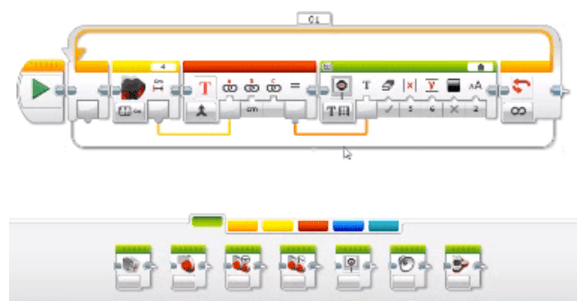
Figure 4: LEGO MINDSTORMS EV3 program to detect and track the position of the water level within the permeameter. - 4: LEGO MINDSTORMS EV3 program to detect and track the position of the water level within the permeameter.
Vocabulary/Definitions
aquifer: Underground water storage which lies between two low-permeability layers.
earth dam: Massive manmade water barrier used to store water for supply and/or power purposes.
groundwater: Water located below the land surface that occupies the voids of the soil.
landslide: Natural disaster which consists of a wide range of ground movement.
mechatronic components: Combined tools that comprise mechanics, electronics and robotics fields in order to design and manufacture useful products.
permeability or coefficient of permeability: A measure of the soil's ability to allow water to flow through its pore spaces.
permeameter: A device used to calculate the coefficient of permeability.
saturation: When all voids of a particular soil are full of water.
sensor: A device that detects or senses a signal, which is a form of energy.
soil: Natural body consisting of three phases: mineral-water-air. Soil is derived from rocks that have been altered by various chemical mechanical and environmental processes. Different soils include gravel, sand, silt, and clay.
soil voids/pores: The spaces between soil particles, which may be filled with liquids (especially water), or gases (especially air).
ultrasonic sensor: A sensor used to detect proximity of objects by using dual (transmitter-receiver) ultrasonic signal.
ultrasonic signal: A signal that measures a sound wave by timing how long it takes for the sound to bounce off objects.
Assessment
Pre-Activity Assessment
Worksheet: Have students complete the Soil Permeability Pre-Evaluation. Review their answers to gauge their familiarity with the activity topics.
Activity Embedded Assessment
Student Explanations: Randomly select students to explain what they see during the permeability tests. Ask them to tell you which soils are more or less permeable based on the variety of samples you have in the classroom. Have them defend their answers with data and observations.
Post-Activity Assessment
Post Activity Worksheet: Have students complete the Soil Permeability Post-Evaluation. Review their answers to gauge their takeaways from the activity.
Question and Answer: Ask students the following questions. Have the students write down their answers. Call on students to share their answers with the class. Did everyone get the same answer?
- What is permeability? (Answer: The measurement of water's ability to flow through soil.)
- Why is permeability important in construction and engineering? (Answer: When a civil engineer is focused on earth structures design, water behavior becomes important. The presence of water, in most cases, provides additional forces that can destabilize a building site. Engineers often need to identify the presence of ground water, calculate the water pressure that it provides to the element under construction, and accurately predict the water flow around their construction plan. In that sense, measuring water flow can help to design more durable and cost-efficient structures.)
- What is the ground water table? (Answer: Water located below the land surface that occupies the voids of the soil.)
- Where does rainfall water go after it lands on a soil surface? (Answer: Part of it slides down through the land surface, and depending on the permeability of the soil media, the remaining part infiltrates down into the soil mass.)
- Why does groundwater travel slower than a river? (Answer: Because groundwater travels through less void space than an open channel, such as a river.)
- List at least three cases where permeability is used in civil engineering. (Answer: 1. Building a dam. The main goal of a dam is to retain water behind it, so engineers choose low permeability areas for dams. 2. Deep excavations. The lack of knowledge about groundwater position and permeability may cause severe damage to an open excavation, and even worse to personnel inside the trench. 3. The design of filters for drainage. The best way to control groundwater inside land slopes and excavations is to organize and correctly drain the water out of these elements)
- Why do you think data collected from a test is more accurate if sensors and mechatronics tools are used? (Answer: Because mechatronics tools minimize errors that human beings make while reading results.)
- What elements influence the value of permeability? (Answer: Soil particles, voids between grains, and type of fluid.)
Subscribe
Get the inside scoop on all things TeachEngineering such as new site features, curriculum updates, video releases, and more by signing up for our newsletter!More Curriculum Like This

Students learn about landslides, discovering that there are different types of landslides that occur at different speeds — from very slow to very quick. All landslides are the result of gravity, friction and the materials involved. Students learn what makes landslides dangerous and what engineers ar...

Students learn how water flows through the ground, what an aquifer is, and what solid properties predict groundwater flow. Groundwater is one of the largest sources of drinking water, so environmental engineers need to understand groundwater flow in order to tap into this important resource.
References
http://aegsrv2.esci.keele.ac.uk/earthlearningidea/PDF/Permeability_of_soils_Final.pdf
http://classic.globe.gov/tctg/passthrough.pdf?sectionId=102&lang=EN
Copyright
© 2012 by Regents of the University of Colorado; original © 2012 Polytechnic Institute of New York UniversityContributors
Eduardo Suescun; Ryan Cain; Russ Holstein; Magued IskanderSupporting Program
AMPS GK-12 Program, Polytechnic Institute of New York UniversityAcknowledgements
This activity was developed by the Applying Mechatronics to Promote Science (AMPS) Program funded by National Science Foundation GK-12 grant no. 0741714. However, these contents do not necessarily represent the policies of the NSF, and you should not assume endorsement by the federal government.
Last modified: October 16, 2020






User Comments & Tips